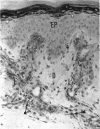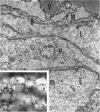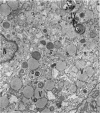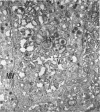Abstract
Plasma lipoprotein alterations in nine insulin-dependent diabetics with hyperlipemia have been related to the lipid accumulating in eruptive xanthomas evolving in these patients. Histochemical and electron microscopic examination of xanthomas have been correlated with the lipid analyses in order to obtain additional evidence regarding the lipoprotein origin of lipids accumulating in the lesions. Both analytical and morphologic evidence suggested that circulating chylomicrons significantly contribute to the xanthoma lipids. All the patients had large quantities of circulating triglyceriderich chylomicrons which carried approximately 70% of the triglyceride found in the plasma. The fatty acid pattern of chylomicron and xanthoma triglycerides were similar. Triglyceride constituted the major lipid found in the xanthomas when they were sampled during their eruption. These findings, take in conjunction with histochemical and electron microscopic evidence of chylomicron particles in the dermal capillary walls, support the theory that blood lipoproteins, and particularly chylomicrons, permeated the vascular walls and the triglycerides carried by these lipoproteins apparently accumulated in tissue macrophages and perithelial cells which evolved into foam cells. Initiation of appropriate therapy resulted in clearance of the chylomicronemia and a concomitant resolution of the xanthomas as reflected by a decrease in total xanthoma lipid. Sequential studies of resolving xanthomas in five patients revealed that xanthoma triglyceride was mobilized more rapidly than cholesterol, resulting in a redistribution of the xanthoma lipids, so that the resolving lesions were cholesterol rich. Consistent with this change in lipid composition, correlative electron microscopy revealed loss of amorphous material from many of the foam cell vacuoles.
Full text
PDF
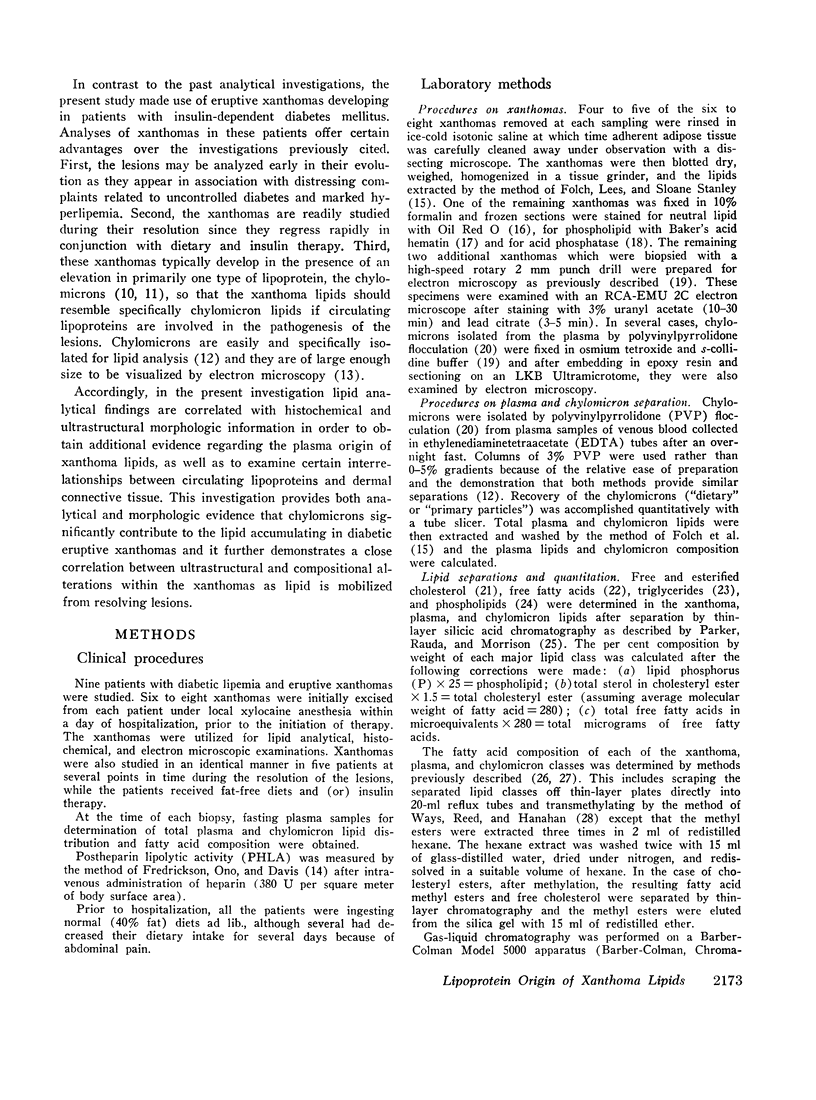

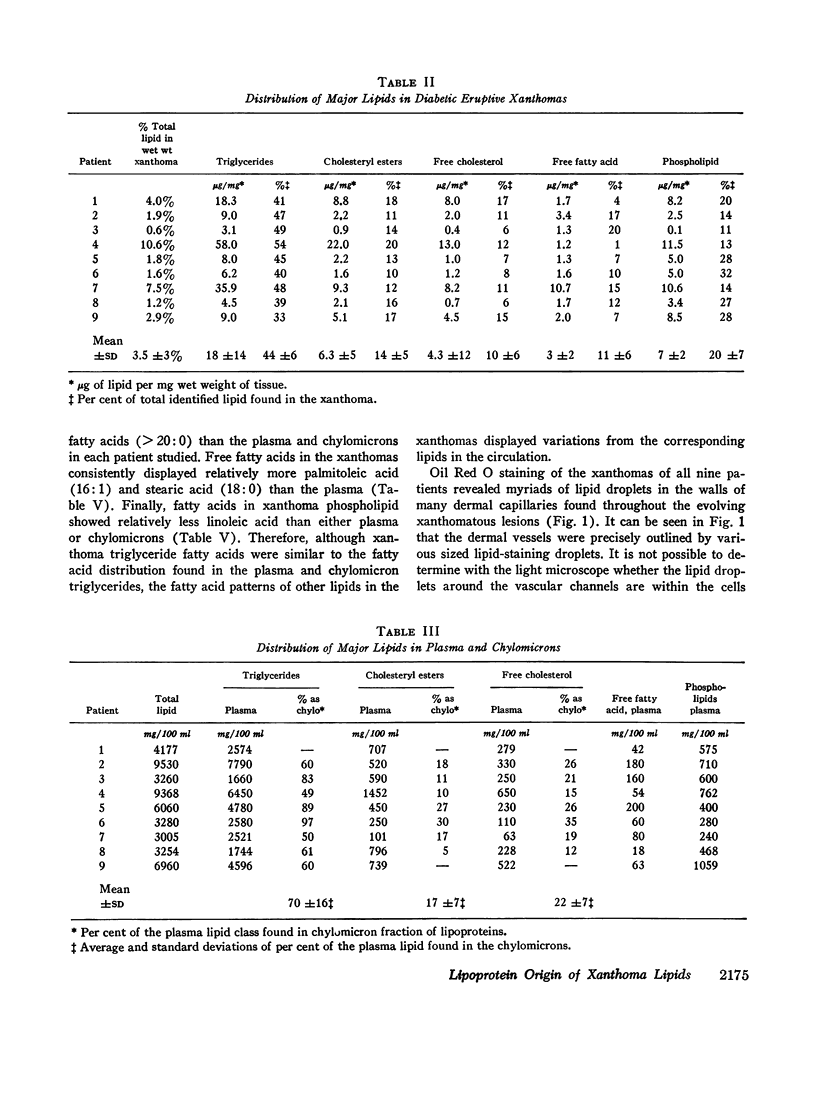
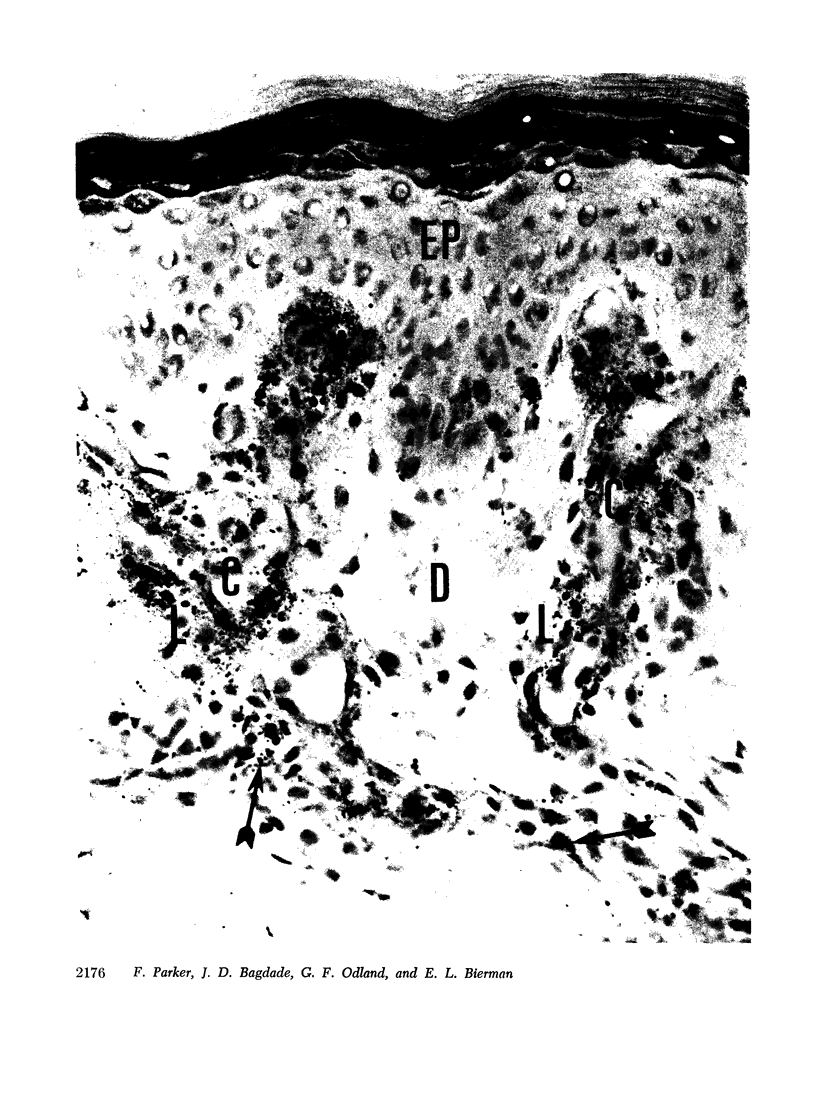
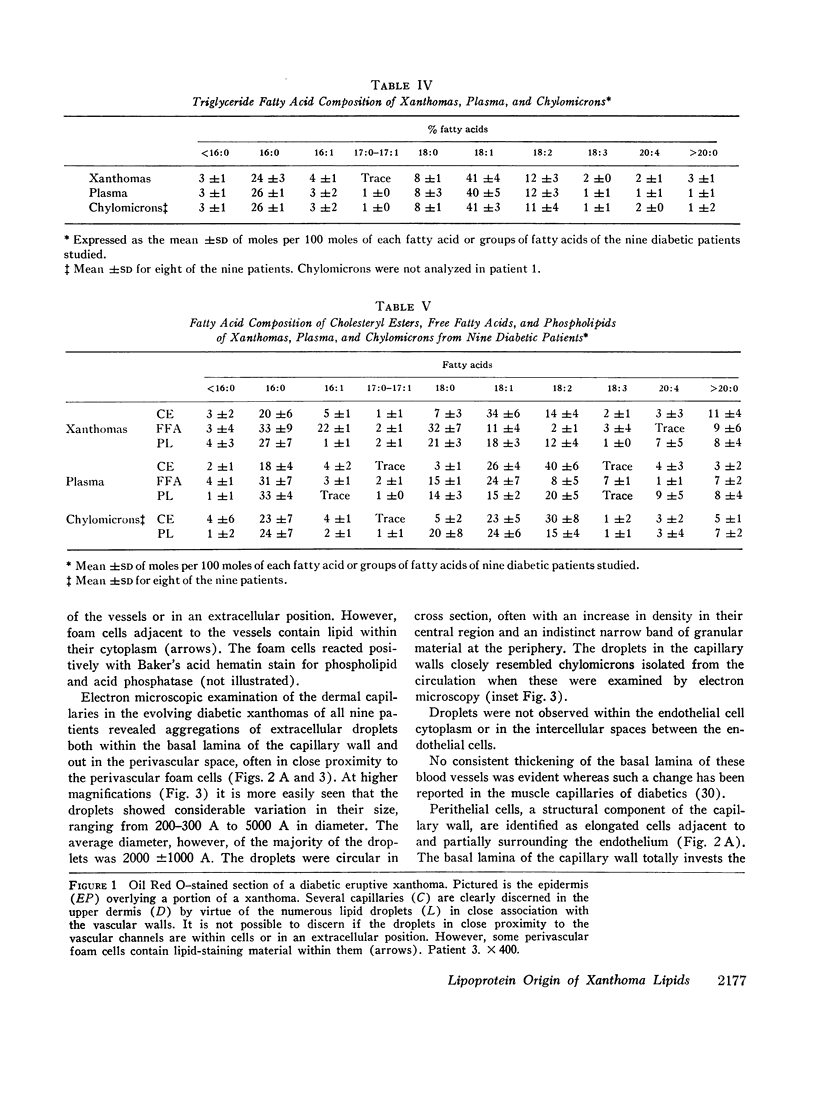
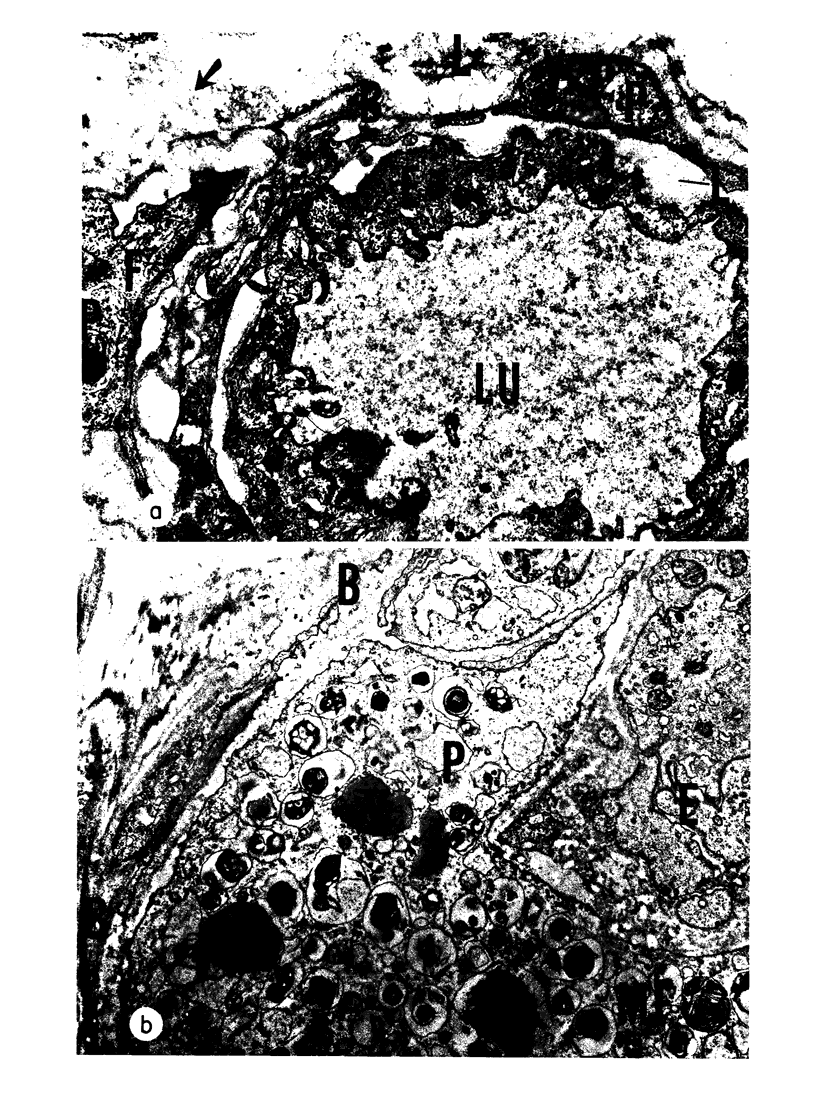
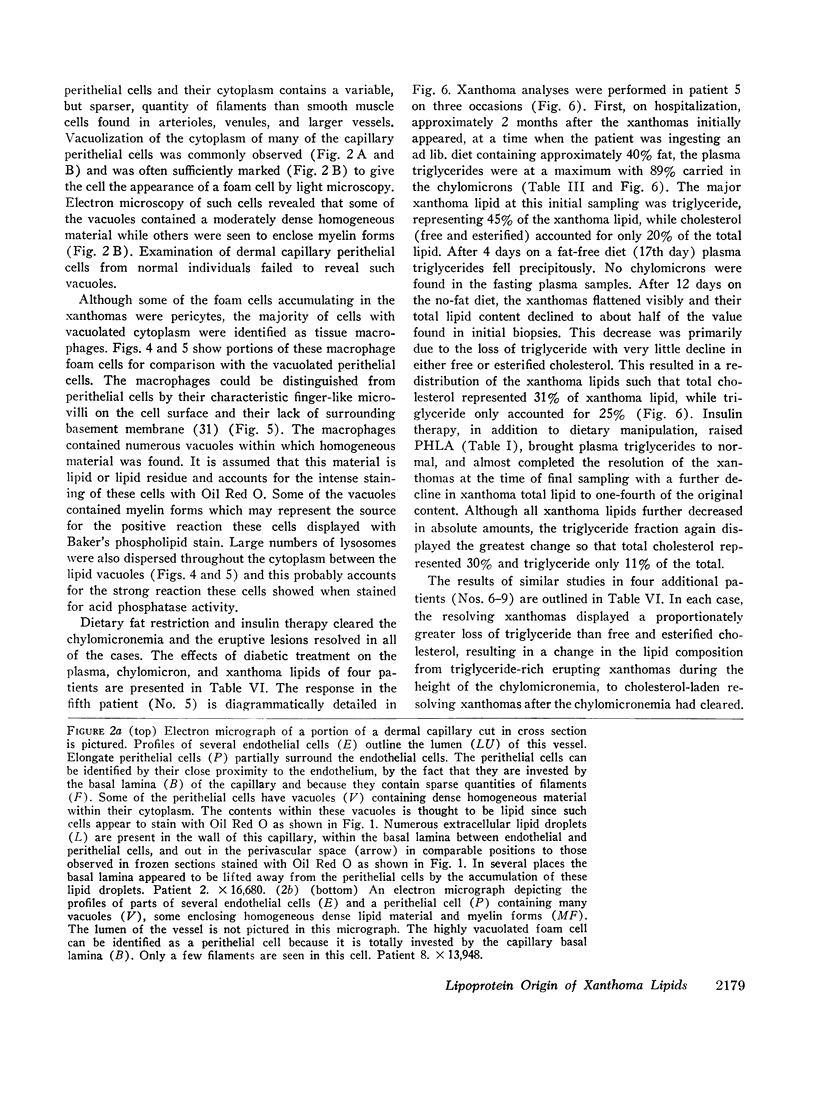
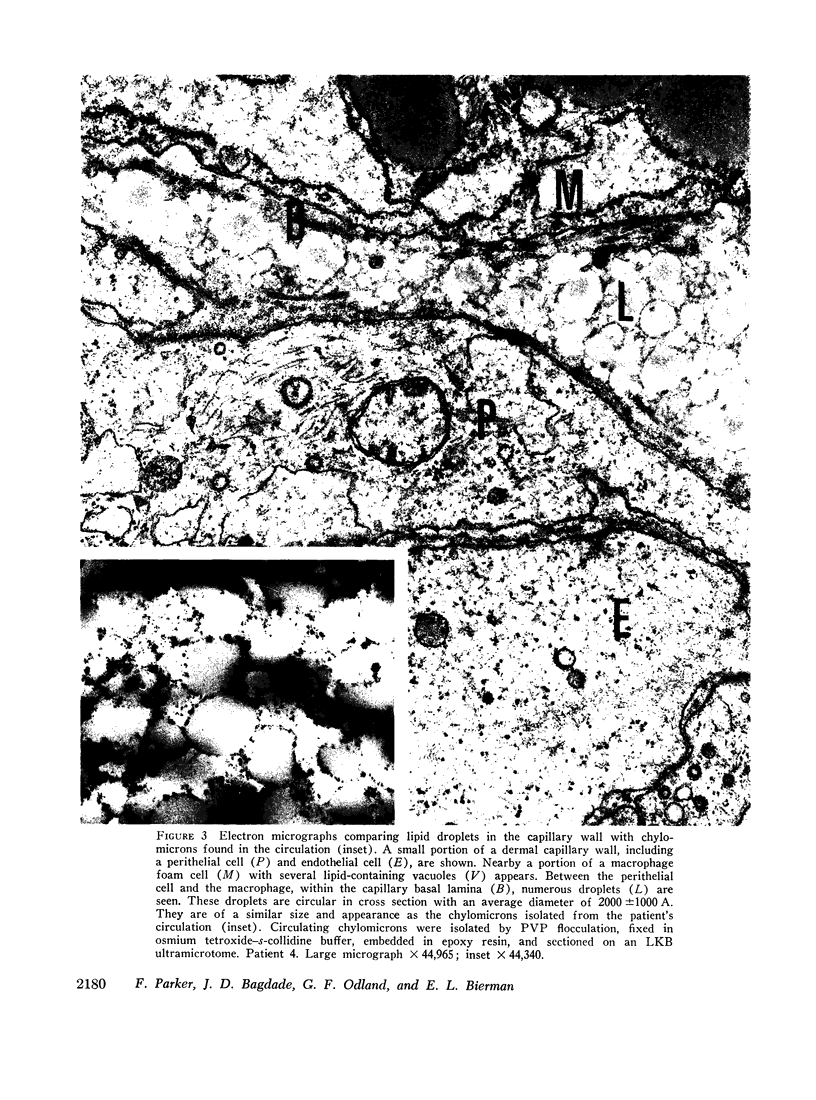
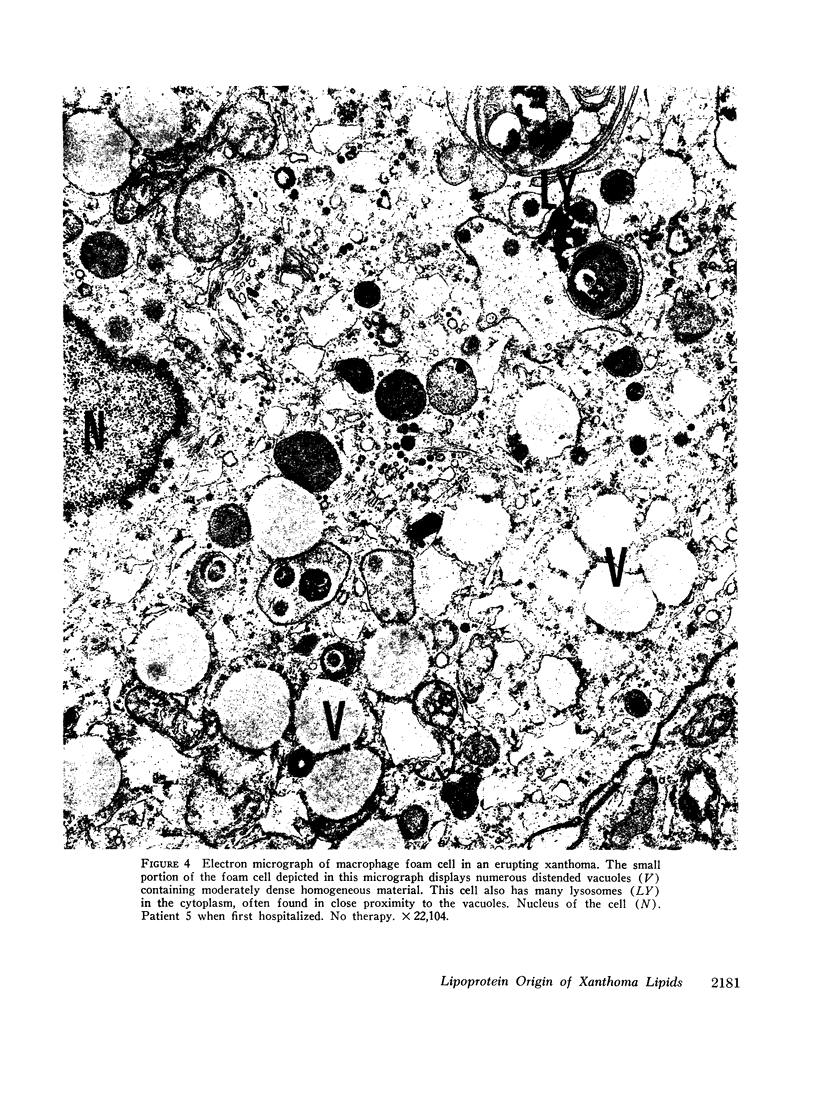
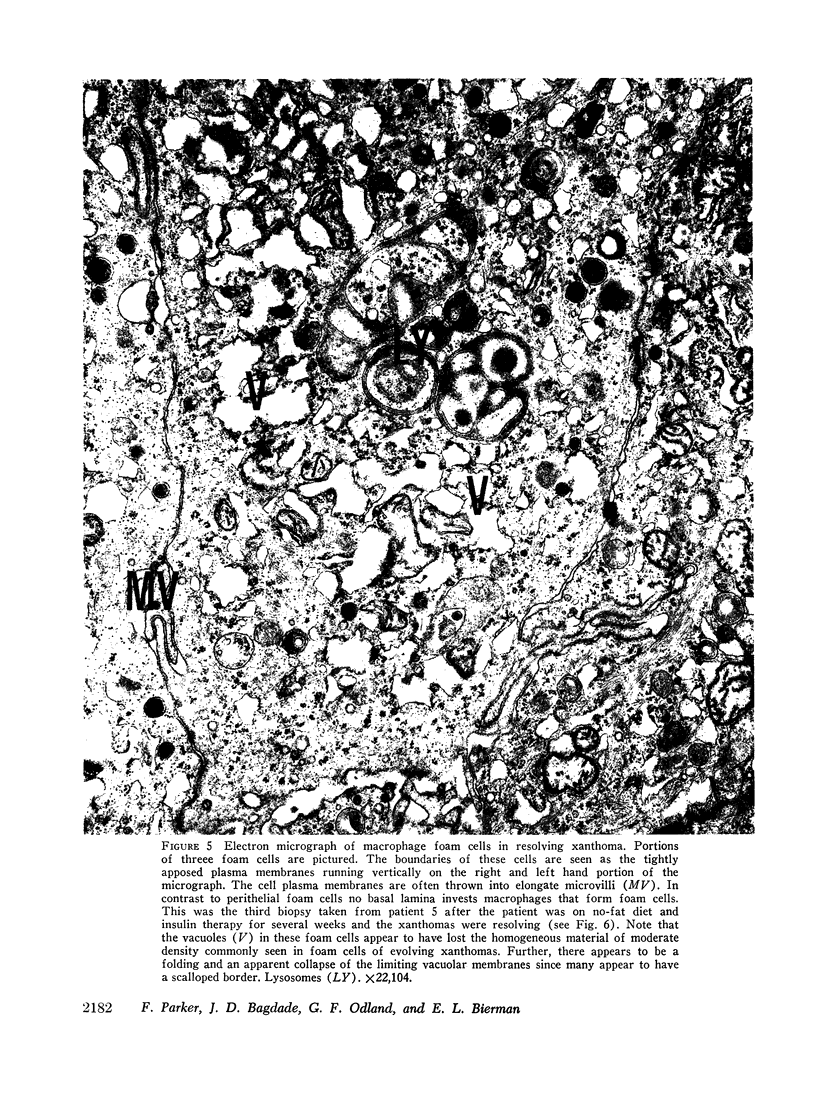


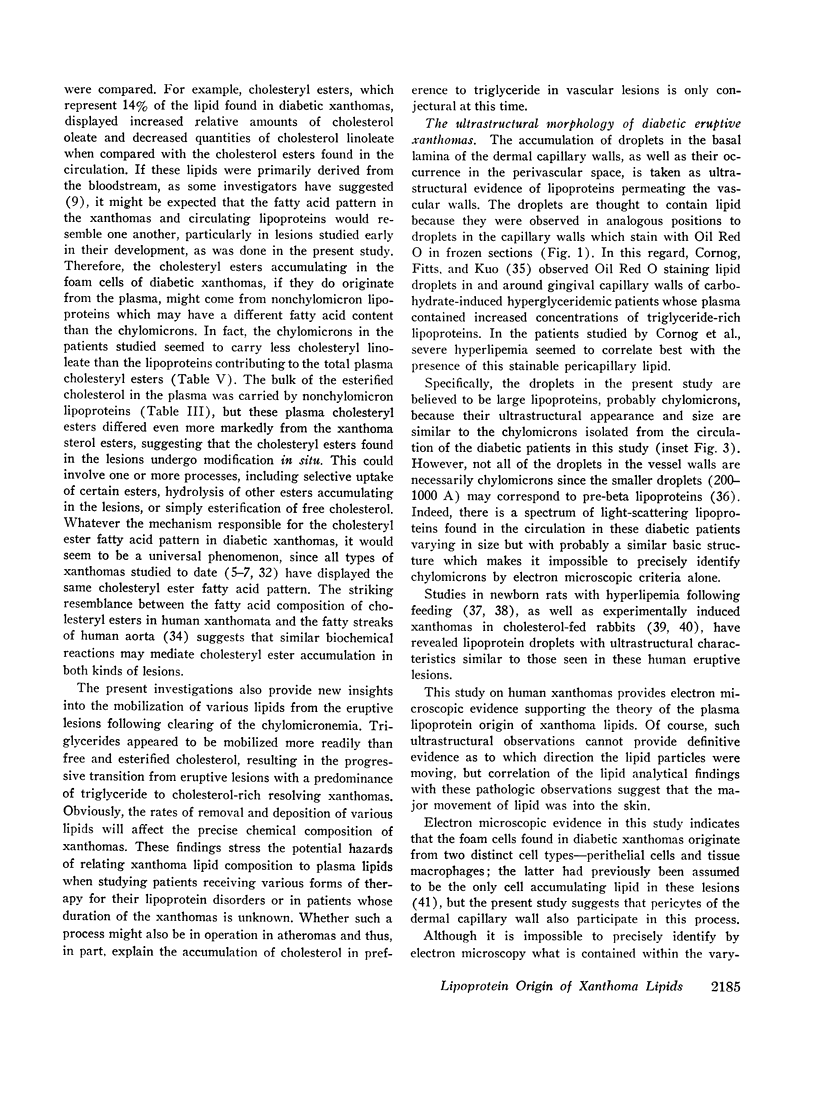
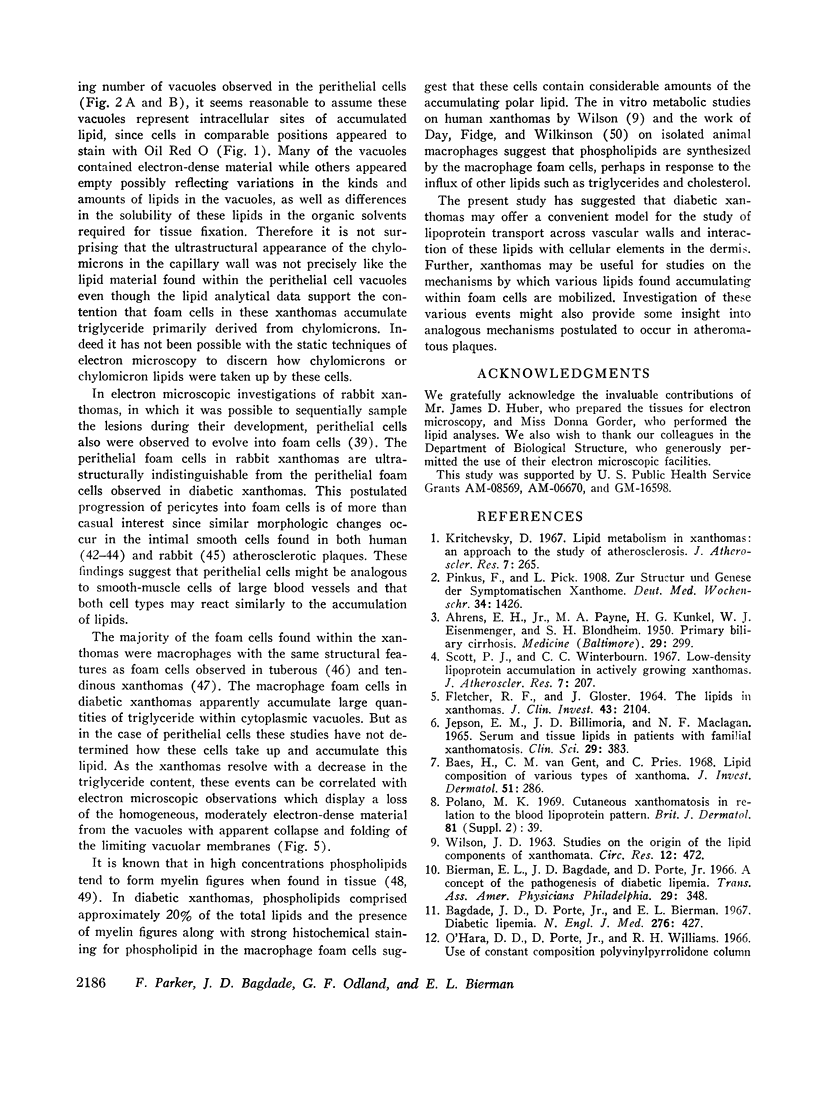
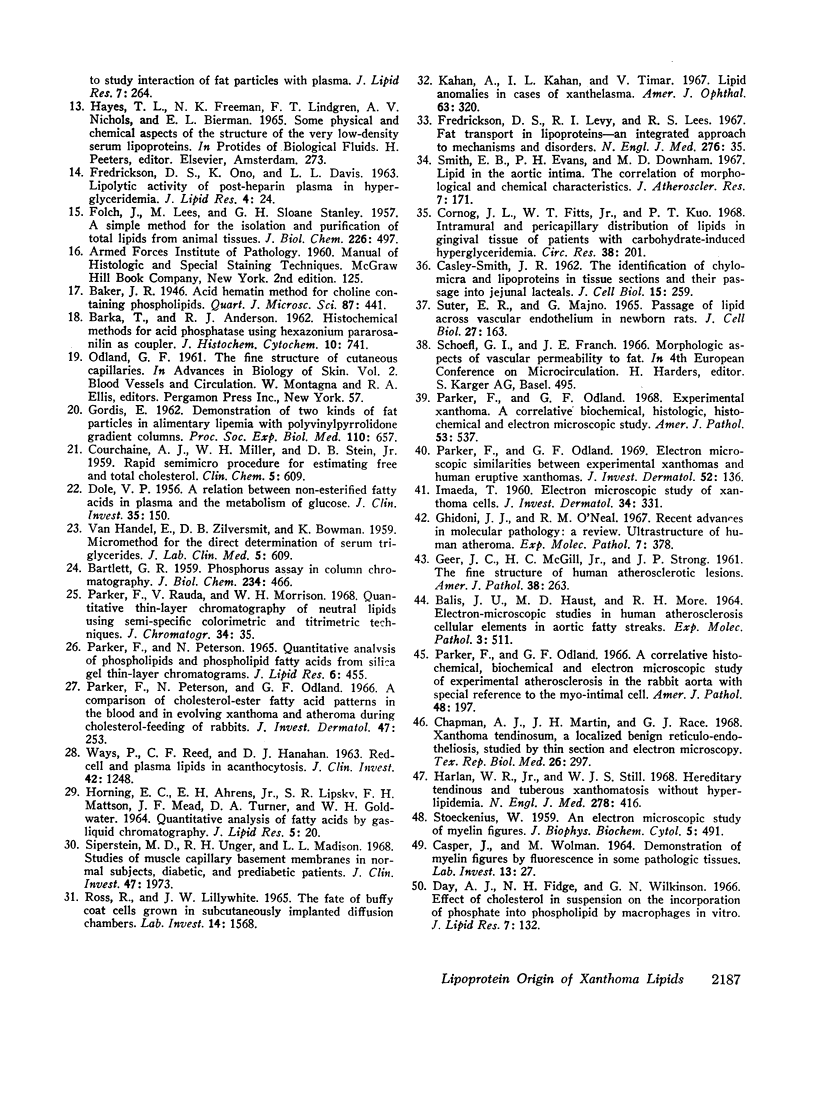
Images in this article
Selected References
These references are in PubMed. This may not be the complete list of references from this article.
- AHRENS E. H., Jr, PAYNE M. A., KUNKEL H. G., EISENMENGER W. J., BLONDHEIM S. H. Primary biliary cirrhosis. Medicine (Baltimore) 1950 Dec;29(4):299–364. doi: 10.1097/00005792-195012000-00002. [DOI] [PubMed] [Google Scholar]
- BALIS J. U., HAUST M. D., MORE R. H. ELECTRON-MICROSCOPIC STUDIES IN HUMAN ATHEROSCLEROSIS; CELLULAR ELEMENTS IN AORTIC FATTY STREAKS. Exp Mol Pathol. 1964 Oct;90:511–525. doi: 10.1016/0014-4800(64)90031-0. [DOI] [PubMed] [Google Scholar]
- BARTLETT G. R. Phosphorus assay in column chromatography. J Biol Chem. 1959 Mar;234(3):466–468. [PubMed] [Google Scholar]
- Baes H., van Gent C. M., Pries C. Lipid composition of various types of xanthoma. J Invest Dermatol. 1968 Oct;51(4):286–293. [PubMed] [Google Scholar]
- Bagdade J. D., Porte D., Jr, Bierman E. L. Diabetic lipemia. A form of acquired fat-induced lipemia. N Engl J Med. 1967 Feb 23;276(8):427–433. doi: 10.1056/NEJM196702232760802. [DOI] [PubMed] [Google Scholar]
- Bierman E. L., Bagdade J. D., Porte D., Jr A concept of the pathogenesis of diabetic lipemia. Trans Assoc Am Physicians. 1966;79:348–360. [PubMed] [Google Scholar]
- CASLEY-SMITH J. R. The identification of chylomicra and lipoproteins in tissue sections and their passage into jejunal lacteals. J Cell Biol. 1962 Nov;15:259–277. doi: 10.1083/jcb.15.2.259. [DOI] [PMC free article] [PubMed] [Google Scholar]
- CASPER J., WOLMAN M. DEMONSTRATION OF MYELIN FIGURES BY FLUORESCENCE IN SOME PATHOLOGIC TISSUES. Lab Invest. 1964 Jan;13:27–31. [PubMed] [Google Scholar]
- COURCHAINE A. J., MILLER W. H., STEIN D. B., Jr Rapid semi-micro procedure for estimating free and total cholesterol. Clin Chem. 1959 Dec;5:609–614. [PubMed] [Google Scholar]
- Chapman A. J., Martin J. H., Race G. J. Xanthoma tendinosum, a localized benign reticulo-endotheliosis, studied by thin section and electron microscopy. Tex Rep Biol Med. 1968 Fall;26(3):297–301. [PubMed] [Google Scholar]
- Cornog J. L., Jr, Fitts W. T., Jr, Kuo P. T. Intramural and pericapillary distribution of lipids in gingival tissue of patients with carbohydrate-induced hyperglyceridemia. Circulation. 1968 Jul;38(1):201–208. doi: 10.1161/01.cir.38.1.201. [DOI] [PubMed] [Google Scholar]
- DOLE V. P. A relation between non-esterified fatty acids in plasma and the metabolism of glucose. J Clin Invest. 1956 Feb;35(2):150–154. doi: 10.1172/JCI103259. [DOI] [PMC free article] [PubMed] [Google Scholar]
- Day A. J., Fidge N. H., Wilkinson G. N. Effect of cholesterol in suspension on the incorporation of phosphate into phospholipid by macrophages in vitro. J Lipid Res. 1966 Jan;7(1):132–140. [PubMed] [Google Scholar]
- FLETCHER R. F., GLOSTER J. THE LIPIDS IN XANTHOMATA. J Clin Invest. 1964 Nov;43:2104–2111. doi: 10.1172/JCI105084. [DOI] [PMC free article] [PubMed] [Google Scholar]
- FOLCH J., LEES M., SLOANE STANLEY G. H. A simple method for the isolation and purification of total lipides from animal tissues. J Biol Chem. 1957 May;226(1):497–509. [PubMed] [Google Scholar]
- FREDRICKSON D. S., ONO K., DAVIS L. L. LIPOLYTIC ACTIVITY OF POST-HEPARIN PLASMA IN HYPERGLYCERIDEMIA. J Lipid Res. 1963 Jan;4:24–33. [PubMed] [Google Scholar]
- GEER J. C., McGILL H. C., Jr, STRONG J. P. The fine structure of human atherosclerotic lesions. Am J Pathol. 1961 Mar;38:263–287. [PMC free article] [PubMed] [Google Scholar]
- GORDIS E. Demonstration of two kinds of fat particles in alimentary lipemia with polyvinylpyrrolidone gradient columns. Proc Soc Exp Biol Med. 1962 Aug-Sep;110:657–661. doi: 10.3181/00379727-110-27608. [DOI] [PubMed] [Google Scholar]
- Ghidoni J. J., O'Neal R. M. Recent advances in molecular pathology: a review ultrastructure of human atheroma. Exp Mol Pathol. 1967 Dec;7(3):378–400. doi: 10.1016/0014-4800(67)90049-4. [DOI] [PubMed] [Google Scholar]
- HORNING E. C., AHRENS E. H., Jr, LIPSKY S. R., MATTSON F. H., MEAD J. F., TURNER D. A., GOLDWATER W. H. QUANTITATIVE ANALYSIS OF FATTY ACIDS BY GAS-LIQUID CHROMATOGRAPHY. J Lipid Res. 1964 Jan;5:20–27. [PubMed] [Google Scholar]
- Harlan W. R., Jr, Still W. J. Hereditary tendinous and tuberous xanthomatosis without hyperlipidemia. A new lipid-storage disorder. N Engl J Med. 1968 Feb 22;278(8):416–422. doi: 10.1056/NEJM196802222780803. [DOI] [PubMed] [Google Scholar]
- IMAEDA T. Electron microscopic study of xanthoma cells. J Invest Dermatol. 1960 May;34:331–337. [PubMed] [Google Scholar]
- Jepson E. M., Billimoria J. D., Maclagan N. F. Serum and tissue lipids in patients with familial xanthomatosis. Clin Sci. 1965 Oct;29(2):383–390. [PubMed] [Google Scholar]
- Kahán A., Kahán I. L., Timár V. Lipid anomalies in cases of xanthelasma. Am J Ophthalmol. 1967 Feb;63(2):320–325. doi: 10.1016/0002-9394(67)91557-7. [DOI] [PubMed] [Google Scholar]
- Kritchevsky D. Lipid metabolism in xanthomas: an approach to the study of atherosclerosis. J Atheroscler Res. 1967 May-Jun;7(3):265–267. doi: 10.1016/s0368-1319(67)80053-x. [DOI] [PubMed] [Google Scholar]
- Parker F., Odland G. F. A correlative histochemical, biochemical and electron microscopic study of experimental atherosclerosis in the rabbit aorta with special reference to the myo-intimal cell. Am J Pathol. 1966 Feb;48(2):197–239. [PMC free article] [PubMed] [Google Scholar]
- Parker F., Odland G. F. Electron microscopic similarities between experimental xanthomas and human eruptive xanthomas. J Invest Dermatol. 1969 Feb;52(2):136–147. [PubMed] [Google Scholar]
- Parker F., Odland G. F. Experimental xanthoma. A correlative biochemical, histologic, histochemical, and electron microscopic study. Am J Pathol. 1968 Oct;53(4):537–565. [PMC free article] [PubMed] [Google Scholar]
- Parker F., Peterson N., Odland G. F. A comparison of cholesterol-ester fatty acid patterns in the blood and in evolving xanthoma and atheroma during cholesterol-feeding of rabbits. J Invest Dermatol. 1966 Sep;47(3):253–259. doi: 10.1038/jid.1966.138. [DOI] [PubMed] [Google Scholar]
- Parker F., Rauda V., Morrison W. H. Quantitative thin-layer chromatography of neutral lipids using semi-specific colorimetric and titrimetric techniques. J Chromatogr. 1968 Mar 26;34(1):35–43. doi: 10.1016/0021-9673(68)80006-8. [DOI] [PubMed] [Google Scholar]
- Polano M. K. Cutaneous xanthomatosis in relation to the blood lipoprotein pattern. Br J Dermatol. 1969;81(Suppl):39–48. doi: 10.1111/j.1365-2133.1969.tb12844.x. [DOI] [PubMed] [Google Scholar]
- Ross R., Lillywhite J. W. The fate of buffy coat cells grown in subcutaneously implanted diffusion chambers. A light and electron microscopic study. Lab Invest. 1965 Sep;14(9):1568–1585. [PubMed] [Google Scholar]
- STOECKENIUS W. An electron microscope study of myelin figures. J Biophys Biochem Cytol. 1959 May 25;5(3):491–500. doi: 10.1083/jcb.5.3.491. [DOI] [PMC free article] [PubMed] [Google Scholar]
- Scott P. J., Winterbourn C. C. Low-density lipoprotein accumulation in actively growing xanthomas. J Atheroscler Res. 1967 Mar-Apr;7(2):207–223. doi: 10.1016/s0368-1319(67)80082-6. [DOI] [PubMed] [Google Scholar]
- Siperstein M. D., Unger R. H., Madison L. L. Studies of muscle capillary basement membranes in normal subjects, diabetic, and prediabetic patients. J Clin Invest. 1968 Sep;47(9):1973–1999. doi: 10.1172/JCI105886. [DOI] [PMC free article] [PubMed] [Google Scholar]
- Smith E. B., Evans P. H., Downham M. D. Lipid in the aortic intima. The correlation of morphological and chemical characteristics. J Atheroscler Res. 1967 Mar-Apr;7(2):171–186. doi: 10.1016/s0368-1319(67)80079-6. [DOI] [PubMed] [Google Scholar]
- Suter E. R., Majno G. Passage of lipid across vascular endothelium in newborn rats. An electron microscopic study. J Cell Biol. 1965 Oct;27(1):163–177. doi: 10.1083/jcb.27.1.163. [DOI] [PMC free article] [PubMed] [Google Scholar]
- WAYS P., REED C. F., HANAHAN D. J. RED-CELL AND PLASMA LIPIDS IN ACANTHOCYTOSIS. J Clin Invest. 1963 Aug;42:1248–1260. doi: 10.1172/JCI104810. [DOI] [PMC free article] [PubMed] [Google Scholar]





